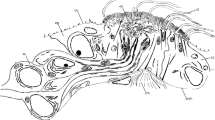Abstract
Two pairs of identified sensory neurons innervating the sucker of Craspedella pedum (designated ADS1, ADS2) were found to accumulate DiO (3,3′-dioctadecyloxacarbocyanine perchlorate) in vivo. The number, position and morphology of these neurons do not change throughout the postembryonic period of life. The axons of the ADS cells run forward within the ventral cords and their dendrites are parallel. They enter the sucker, ramify and terminate in numerous sensory endings in a wide peripheral zone of the disc. SEM reveals a single type of sensilla: small spot-like structures with several short cilia. They are scattered within the zone accommodating the openings of the adhesive glands and their distribution corresponds to that of the stained terminals. TEM observations (including about 20 full reconstructions from serial ultrathin sections) show five types of sensory endings on the disc with the following structures: (1) a short cilium and thin rootlet, (2) aciliary with a normal rootlet and a club-shaped apical portion, (3) aciliary with a club-shaped apical portion and a body similar to the apical part of the rootlet, (4) aciliary with large apical granule and (5) aciliary with small apical granules. Type 2–5 receptors form a morphological series suggesting that they are stages of formation of the common type 4 receptor. Not fully formed type 1 receptors have been found within the epidermis in adult animals. This suggests that, although ADS perikarya persist throughout the life of the animal, the nerve endings they form might be constantly renewed. Judging from the morphological and behavioural data, the functions of the ADS neurons might include: (1) monitoring of the close contact between the surface of the sucker and the substratum prior to adhesion and (2) checking the viscosity of the adhesive secretion prior to release of the sucker.
Similar content being viewed by others
Author information
Authors and Affiliations
Additional information
Accepted: 16 December 1997
Rights and permissions
About this article
Cite this article
Joffe, B., Solovei, I. & Cannon, L. Sensory cells in the sucker of Craspedella pedum (Plathelminthes, Temnocephalida): in vivo staining with DiO and SEM and TEM observations. Zoomorphology 118, 61–68 (1998). https://doi.org/10.1007/s004350050057
Issue Date:
DOI: https://doi.org/10.1007/s004350050057




